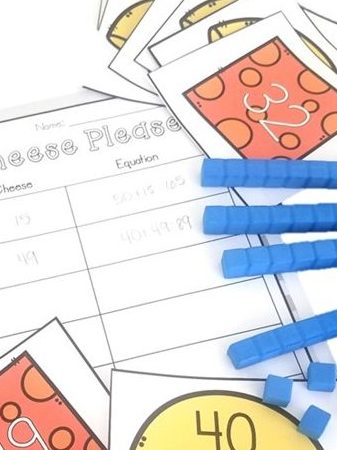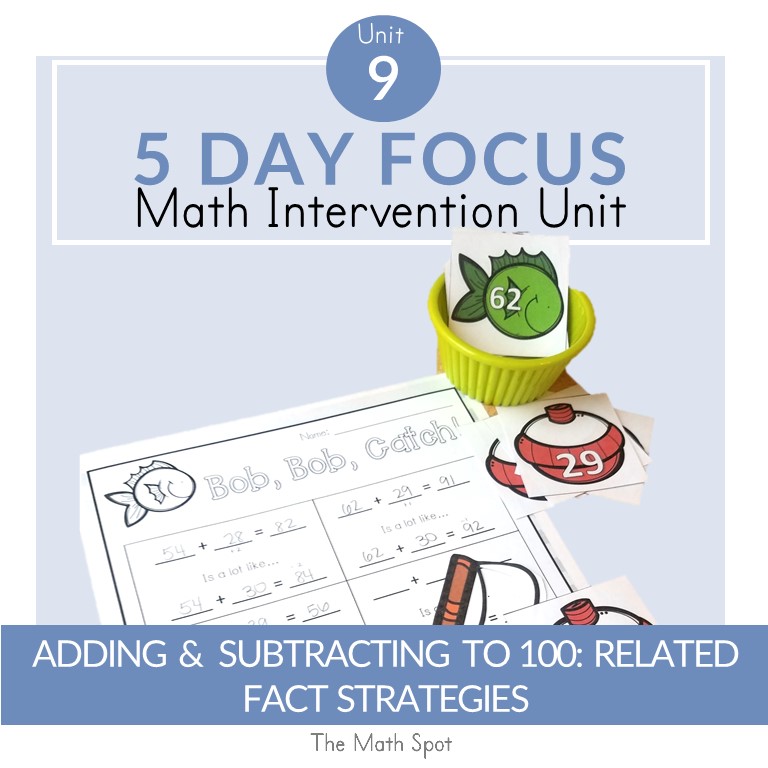This post contains affiliate links. This means that when you make a purchase, at no additional cost to you, I will earn a small commission.
If you are on Facebook, surely, you have seen rants about how Common Core Math is the WORST. Seemingly elaborate diagrams are drawn to add simple numbers such as 19 + 6. Students are drawing number bonds to break apart the 6 into a 1 and a 5, are circling numbers, writing new equations. All to solve a relatively simple problem.
It begs the questions, Why are there so many different strategies for addition? Are all of these addition strategies even necessary?
My short answer is, no, it is not necessary that every student master each of the specific different strategies for addition that your textbook may be teaching. The longer answer is that flexibility with numbers and flexibility with a wide variety of strategies is absolutely necessary.
So that answer begs a new question: Which addition strategies *are* necessary and when is it okay to say enough is enough with a strategy that isn’t clicking for your students?

Some Strategies Are Simply Stepping Stones!
The first thing to consider is that many of the strategies that are taught in school are stepping stones for strategies that may ultimately be more efficient in the future.
Quick! Add 7 + 4. How did you find the total? You might have just known 7 + 4 automatically. Or perhaps you thought about 7 + 4 as being “one more than” 7 + 3. It’s near a known fluent fact. In any case, knowing from memory and using related facts are efficient strategies, but they are quite complex! We would never expect, for example, a kindergartener to be able to execute these strategies. There are stepping stones that they need to cross before they can use these strategies!
Those stepping stones would be: Counting all to add, counting on to add, knowing partners of ten, knowing how to decompose numbers up to ten, and understanding that addition really just means putting numbers together and you can be flexible in terms of how you go about doing that!
So before abandoning a strategy altogether ask yourself, is this strategy the end goal and perhaps a strategy my student doesn’t need to be comfortable with, or is this a critical stepping stone that I need my student to understand for future instruction?
Some Strategies Are About MORE Than Just Addition!
When it comes to adding multi-digit numbers, you may be thinking to yourself, let’s just use the standard algorithm! It’s quick, easy and you can avoid all of those other stepping stones altogether! Rest assured, the procedure and algorithm will be taught further on down the line. Take a look at the standard at grade 4: Fluently add and subtract multi-digit whole numbers using the standard algorithm.
However, prior to grade 4, let’s use the operation of addition to teach and learn as much about place value as we can!
Students in 2nd grade might learn about decomposing 2-digit numbers so that they are easier to combine and add together.

Take the expression 27 + 32. First, a student would decompose 27 into 20 and 7 and 32 into 30 and 2. If you were to do 27 plus 32 in your head, it is likely that this is the first step that you might take.
As adults, we flexibly break numbers apart so that we are able to do mental math. A child often thinks the number 27 just simply means “two seven” if they aren’t grounded in place value.
Next, a student would be asked to put the tens together. As adults, we know that 27 + 32 is the same as 20 + 30 + 7 + 2 but a student learning the traditional algorithm learns nothing about the flexibility of numbers!
The step of putting 20 and 30 together in and of itself is a powerful step in learning about place value. Students can see that adding 20 + 30 is really as simple as adding 2 + 3. If 20 means two tens and 30 means three tens, 20 + 30 is really just putting 2 tens and 3 tens together. 5 tens = 50. More on adding decade numbers mentally HERE.
Remember those viral Facebook posts? I’m sure the comments would be running WILD right now after my last paragraph.
Yes. This is A LOT more steps.
Yes. There is significantly more opportunity for error in these steps.
Yes. Yes. Yes.
But I’m not teaching the procedure of addition. I am teaching place value concepts by USING addition and I am developing flexible thinkers who, someday, will perform mental calculations with ease.
Are there Other Skills or Strategies That Need to Be Prioritized First?
Let’s try another one. Quick! Add 42 + 23… no paper, no calculator, just add as quickly as you can!
How did you find the total this time? Perhaps you combined the tens for a total of 6 tens and the ones for a total of 5 ones noting the total of 65. Or maybe you started at 42 and added 2 tens (52, 62) and then added 3 more ones (63, 64, 65). Either strategy is valid but both are potentially complex mental processes!
In order to solve this problem mentally, a student would need to understand:
- The 2 digits of a two-digit number as the number of tens and ones
- How to add decade numbers together
- How to add ten to a given 2-digit number
- …and have fluency with single-digit addition facts!
Before abandoning a strategy with your students stop to notice whether their difficulty with a strategy is because of the strategy itself or because they are missing foundational skills necessary to see how that strategy works.
Is My Students’ Ability to Use a Specific Written Notation Critical?

Many times our mental math requires holding multiple pieces of information at once. For example, adding 32 + 47 as in the diagram to the left.
One strategy to use to add these numbers is to start at 32 and add on manageable pieces of the 47.
A student might start by adding 32 + 40– but then they would need to mentally keep track of the fact that the total of 32 and 40 is 72 AND that they still need to add on 7 more.
Ultimately, this is intended to be a mental strategy– students are simply learning that you can decompose an addend and add it on a bit at a time to make the addition more manageable.
But when students start to use this strategy, it’s easier for them to have a written way to note their thinking so the mental burden isn’t so great.
Before abandoning a strategy, think to yourself– is my student struggling with their understanding of the strategy or is it the notation that might be getting in their way? Is there a different way this strategy could be recorded that might be more natural for my student to understand? Could hands-on tools be used to demonstrate this strategy instead?
How Do You Know Which Different Strategies for Addition are Necessary?
Ask yourself these questions:
- Is this strategy teaching my students something important about numbers or how operations work? Is the learning happening within this strategy bigger than the strategy itself?
- Is this strategy critical in order to move to a more efficient strategy later?
- Is this strategy ultimately supposed to be a written strategy or are we adding a notation to help students keep track of a mental math strategy?
- Does my student have other strategies that allow them to think flexibly about these numbers?
- Is there another skill or strategy that my students is lacking that needs to be prioritized right now?
Related Resources
Each of these resources helps to illuminate addition strategies through hands-on tools, visual models and written notation. Each easy-to-use unit focuses on one addition strategy and allows you to assess, teach, practice and assess again. Units are simple and fun to implement!







